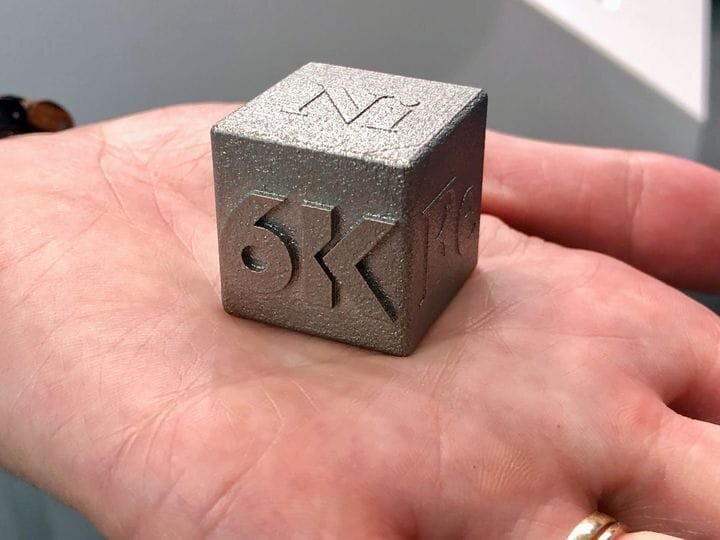![A 3D printed metal cube made from an impossible alloy of six high-entropy metals [Source: Fabbaloo]](https://fabbaloo.com/wp-content/uploads/2020/05/image-asset_img_5eb08ca792bd3.jpg)
I had a chance to speak directly with the folks at 6K Additive, who have developed a revolutionary new method of producing fine metal powders for additive manufacturing applications.
I’ve written previously about the new company, but seeing the powder samples and 3D prints in person revealed a bit more about their unusual production process.
Metal powders are essential for modern additive manufacturing, as most systems use a powder bed / laser approach for selectively sintering metal powders. This means that the powder should be uniform in size to ensure a consistent sintering process.
6K Additive is able to produce ultra-high quality metal powders of this type at very low cost, with some highly unusual properties, as well. How do they achieve this?
Metal Powder Plasma Production
In typical powder manufacturing systems, a hot plasma is created, and then raw metal is added. The plasma melts the metal into droplets, which freeze and fall out at the bottom. These are collected and sorted for quality. The ideal metal particles are perfectly spherical and of specific diameters.
Unfortunately, the usual plasma process tends to be rather inefficient, as the non-uniform plasma causes droplets and particles of varying sizes and shapes. There are good particles made, however, but they are mixed in with poor quality particles. Post-plasma sorting pulls out the good particles, but leaves up to 90% waste material. In some cases this waste powder cannot be reused, and we’re told by 6K Additive that some operations literally have piles of waste metal powder because of this.
6K Additive Microwave Plasma
![Mock-up of 6K Additive’s microwave plasma system [Source: Fabbaloo]](https://fabbaloo.com/wp-content/uploads/2020/05/image-asset_img_5eb08ca7f02b8.jpg)
6K Additive’s secret seems to be their new microwave-generated plasma system. By using microwaves, they are able to very precisely control the conditions in which the metal is melted into droplets. By playing with time, temperature and flows, they can use the natural surface tension of the metals to create large quantities of near-perfectly spherical metal particles, and their microscopic images of powder shows this to be true. 6K Additive claims 90-95% efficiency in doing so.
There’s an enormous financial advantage that can be realized here: if the competition is producing powder at only 10% efficiency when 6K Additive can do so at 90% efficiency, I can see the price of the product dropping or their profit levels rising significantly.
6K Additive Unobtainium Alloy
There is another advantage that is a bit more subtle, but equally shocking. The 6000K microwave plasma process (hence their company name) is able to handle multiple types of metals simultaneously. Thus they are able to produce alloy powders.
The even more interesting thing is that the process allows for the mixing of high entropy metals that cannot be achieved in other processes. They can produce highly unusual alloy powders that can then be 3D printed.
At top you see an image of a metal cube, but it’s literally made from “unobtainium”. It’s made from an alloy of six different metals, including copper, iron, nickel, titanium and others. I’m not even sure what to think about this, as the existence of such alloys has not been considered by industry due to the previous impossibility of obtaining them.
6K Additive says they have proven out a system including both microwave plasma and input metal preparation steps that can be scaled to very high volumes, and they expect to have a plant running in 2020Q1.
Via 6K Additive

